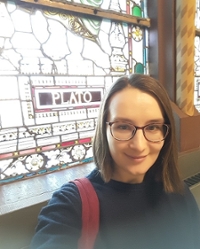Aiste Celkyte
Researcher
- Name
- Dr. A. Celkyte
- Telephone
- +31 71 527 6176
- a.celkyte@hum.leidenuniv.nl
- ORCID iD
- 0000-0001-6556-8324

Aiste Celkyte is a researcher at the Leiden University Centre for the Arts in Society.
Researcher
- Faculty of Humanities
- Centre for the Arts in Society
- Griekse T&C
- Celkyte A. (2024), The School of Hypatia and the Problem of the Gendered Soul. In: Brill S. & McKeen C. (Eds.), The Routledge Handbook of Women and Ancient Greek Philosophy. Routledge Handbooks in Philosophy. London: Routledge.
- Celkyte A. (2024), The stoics and economic rationality, ΠΗΓΗ / FONS 7–8: 221–237.
- Celkyte A. & de Gruijter D. 18 May 2024, De Stoïcijnse Arena: Dr. Aiste Čelkyte. De Stoicijnse School [podcast].
- Čelkytė A. (2024), Chrysippus’ lullaby: the early stoics on the benefits of mousikē, Bulletin of the Institute of Classical Studies : .
- Celkyte A. (2023), Hypatia of Alexandria (c. 350–415 CE): Letter from Synesius of Cyrene to Paeonius (c. 355–415 CE). In: Wills H., Harrison S., Jones E., Martin R. & Lawrence-Mackey F. (Eds.), Women in the history of science. London, UK: UCL Press . 45–52.
- Celkyte A. & Ontiveros C. 22 December 2023, The stoic theory of beauty. Stoa conversations 106 [podcast].
- Celkyte A. & Ontiveros C. 22 December 2023, The Stoic theory of beauty. Stoa Conversations 106 [podcast].
- Celkyte A. (2023), The medico-oikonomic model of human nature in Bryson’s Oikonomikos, Phronesis 68(2): 206-235.
- Celkyte A. (2022), Review of: Helmer E. (2020) Oikonomia: philosophie grecque de l’économie, Kaïnon - anthropologie de la pensée ancienne, : .
- Celkyte A. (26 March 2022), The Stoics on economic agency: is wealth moral?. Stoicism Today: Modern Stoicism. [blog entry].
- Celkyte A. (3 March 2022), Review/Discussion of The Stoic Theory of Beauty Interviewed by Michael McOsker [interview].
- Celkyte A. (1 July 2022), Klasika rauna stoga. 'Aiste Celkyte': Societas Classica. [blog entry].
- Celkyte A. (11 November 2021), Stoic Sage vs. Homo Economicus: The Battle for the Ages or…not? . Leidenartsinsocietyblog. [blog entry].
- Celkyte A. (2021) Beyond the doubt. Review of: Dutsch D. (2020), Pythagorean women philosophers. Between belief and suspicion. Oxford: Oxford University Press. Tijdschrift voor Geschiedenis 134(4): 664-665.
